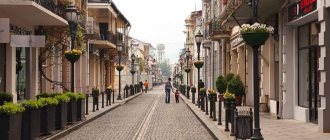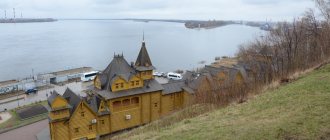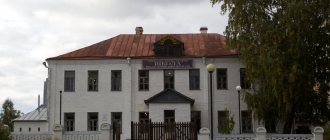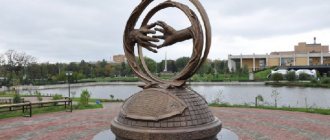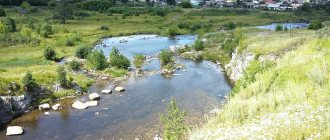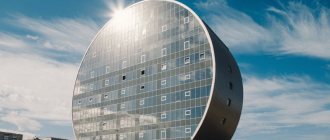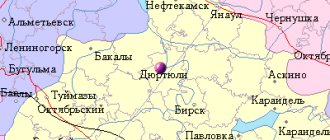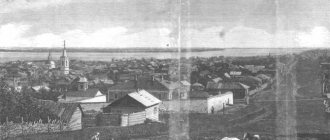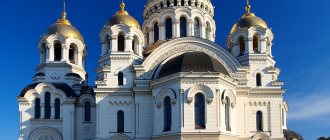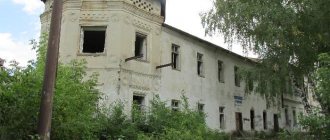| Population: 318,768 people. | City area: 122.00 km2 |
| Time zone:UTC +10 | Telephone code:+7 (4112) |
| Postal code:677 000 | Automotive region:14 |
| Cost of housing per m2: 74,876 rubles. | Average salary: RUB 65,568. |
Yakutsk is the largest city built in the permafrost zone. The city of Yakutsk is the capital of the Republic of Sakha (Yakutia) and the largest port on the Lena River. The city is famous for the contrast of summer and winter temperatures: in winter the thermometer sometimes drops to -65 °C, and on the hottest summer days it can rise to +39 °C. The amplitude of temperature fluctuations in other years exceeded 100 °C. This is due to the fact that the climate of Yakutsk is sharply continental.
Yakutsk on the map of Russia
Unfortunately, many Russians, especially those living in the Western European part of the country, still do not know where Yakutsk is located. It seems to them that Yakutia is a republic located somewhere outside the territory of Russia, somewhere beyond Mongolia or China. Let's dispel doubts. On the map of our vast country, Yakutsk is located in the northeast, on the left bank of the largest river in Eastern Siberia - the Lena.
Yakutsk coordinates: 62.03° north latitude, 129.73° east longitude. You can fly from Moscow to Yakutsk in 6.5 hours by plane, and the trip by car will take about one week.
Popular message topics
- Krasnodar region mineral resources
The fertile Kuban lands have been famous for their riches since ancient times. Various minerals, healthy waters, mud, flammable substances - all this can be found in the Krasnodar Territory. - The work of Guy de Maupassant
Being a follower of the work of Gustave Flaubert, Maupassant sought to support the values of his mentor, and this is a story about the mentality, culture and life of various social strata, - Meadow
During the summer holidays, many people want to go out of town to enjoy nature. How joyful it is when you can run all day across the expanses of meadows, lie in the grass, and weave a wreath of meadow daisies.
Population of Yakutsk
There is a misconception that only representatives of the small people of the North live in Yakutsk - they ride reindeer to work, live in yurts, and in the spring, as soon as it gets warmer, they begin to dig the soil in their garden beds in search of the next portion of diamonds.
And this, of course, is not true. Representatives of the city are quite ordinary citizens with their usual pressing problems.
The mayor of Yakutsk is currently Sardana Avksentieva.
According to the latest data, almost 319 thousand people live in the city of Yakutsk, of which 51.5% are women and 48.5% are men.
By national composition:
- 141 thousand Yakuts,
- 113 thousand Russians,
- 3.9 thousand Ukrainians,
- 3 thousand Kyrgyz,
- 2.8 thousand Evenks,
- 2.5 thousand Buryats,
- 2.3 thousand Armenians,
- 2.1 thousand Evens.
and many other nationalities. In this vein, Yakutsk is a multinational city.
Residents of Yakutsk are famous for their hospitality and broad soul. Every four years, the international Children of Asia Games are held here, where young athletes gather from all over our country and the entire eastern continent. Sport in Yakutia not only strengthens the spirit, but also teaches the younger generation friendship and respect.
The townspeople honor the traditions of their native Republic, proof of this is the annual national holiday Ysyakh - a bright holiday of welcoming summer.
In recent years, several world records have been broken during this holiday - “the most massive playing of the harp (khomus)”, “the most massive drinking of kumis”, “the largest round dance in the world”.
Where to go with a child in Yakutsk
Among the interesting places in Yakutsk there are several, visiting which will bring pleasure to all family members. A young traveler will definitely not be bored in this wonderful city.
Ethnographic complex “Chochur-Muran”
- Opening hours: daily, from 12:00 to 24:00.
- Ticket price: admission is free.
- Phone: +7 924 366‑88-77.
- Address: 5th kilometer of the Vilyuisky tract. Transport stop "Chochur-Muran".
It's easy to have a wonderful day with the whole family in this amazing place. On the territory of the complex you can admire beautifully restored wooden mansions, the premises of which have recreated historical interiors. The main building of the center houses museum exhibitions telling about the flora and fauna of Yakutia and the history of the region. Among the exhibits, tourists will see beautifully made stuffed animals, antique guns, hunting and fishing tools, a collection of awards and banknotes. Young travelers will be able to get closer to the famous Yakut Laikas and ride a dog or reindeer sled. In a small cafe, visitors are offered to try national cuisine.
Republican Circus
- Opening hours: performances are given from Wednesday to Friday at 18:00.
- Ticket price: from 300 rub. up to 1200 rub.
- Phone: +7 411 242‑90-02.
- Website:
- Address: st. Poyarkova, 22. Transport stop "Circus".
The Republican Circus is unique because it is considered the northernmost circus in the world. The building for it was built using special technology, thanks to which performances in the arena are given even in the most severe frosts. A special feature of the circus program is that it includes not only traditional acts performed by jugglers, acrobats, illusionists, and clowns, but also reprises filled with national flavor. You won't see this anywhere else. For 18 years now, the circus arena has become the center of the Republican festival of arts of the original genre “Baby Mammoth”.
- Opening hours: please check the contact phone number.
- Ticket price: excursion, participation in the ritual and lunch from national cuisine will cost 750 rubles. per person.
- Telephone.
- Address: 5th kilometer of the Vilyuisky tract. Transport stop "Chochur-Muran".
The child and his parents will have many vivid impressions after visiting the wonderful ethnographic center located not far from the Chochur-Muran complex. It is a small estate, all the buildings of which are built of wood according to ancient traditions. Guests are greeted by hospitable hosts dressed in national clothes. They introduce visitors to the way of life of the northern peoples, their traditions and rituals, including the cleansing of Algys. Tourists will be able to see the attributes and traditional clothing of a shaman. At the end of the excursion, they will be offered to taste original dishes.
Get to know the sights of other cities - Petropavlovsk-Kamchatsky, Blagoveshchensk, Anadyr, Khabarovsk, Magadan, Yuzhno-Sakhalinsk, Vladivostok, Birobidzhan.
Despite the certain complexity of the journey, because you can only get to Yakutsk by plane, it is undoubtedly worth visiting here. The city will delight guests with colorful sights, and the amazing nature of the North will captivate tourists with its unique charm.
Sights of Yakutsk
Your acquaintance with the capital of Yakutia begins at the Yakutsk airport (airport code - YKS). The airport itself is a local attraction.
Firstly, due to the climatic characteristics of the region, Yakutsk has been used for decades as a testing ground for low-temperature testing of civil aircraft, both Russian and foreign. In the winter of 2011-2012, TU-204CM, Sukhoi SSJ-100, MA-60 (from China) and even such a giant as the Boeing 747 8F cargo plane flew here. The Boeing 787 Dreamliner and other aircraft are waiting here this coming winter. Secondly, in the summer of 2012, a new airport terminal opened, built for the beginning of the V International Sports Games “Children of Asia”.
As many as 700 passengers can pass through this terminal in an hour - it has three telescopic bridges, four escalators, and six elevators. In addition, the airport has a separate baggage claim area and a spacious VIP lounge for VIP class travelers.
The airport is located within the city, but the journey by taxi to the center of Yakutsk does not exceed 20 minutes, even when traveling during mass vehicle movements. If you plan to get to the center by bus, we suggest that you familiarize yourself with the bus schedule for the city of Yakutsk.
On the way to the center, you will pass the turn to the Yakutsk river port (here it is simply called “river port”).
Being a large cargo operator, the river port of Yakutsk is also interesting for ordinary tourists - regular Meteora ships sail from here, as well as comfortable cruise ships Demyan Bedny and Mikhail Svetlov.
No, this ship was not featured in the movie “The Diamond Arm”. In the frame was the ocean liner Pobeda, renamed Mikhail Svetlov for the film. The Yakut ship was built at Austrian shipyards much later than the filming of the film (in 1985).
Like any city whose history goes back several centuries, the city of Yakutsk has its own Old Town - a historical quarter that has preserved the appearance of old Yakutsk.
Here is the wooden tower of the fort - a monument of Russian defense architecture. It is a symbol of Yakutsk and was previously even reflected in the center of the city coat of arms.
For a long time, this tower was located on the territory of the Yakut Museum of Local Lore, until it burned down in a fire in 2002. On August 22 at four o'clock in the morning, a squad of firefighters tried in vain to fight a huge fire. As a result, by the 370th anniversary of the city of Yakutsk, only charred ruins remained from the tower. Two years later, a wooden copy was erected in its place, which reminds citizens and guests of the city of the first Russian fortification on Yakut land.
Another wooden structure in the city center is the Kruzhalo shopping arcade. This is also not genuine antiquity, but only an imitation of it, made in Soviet times.
But the real monument - the building of the Russian-Asian Bank, today belongs to the Museum of Music and Folklore of the Peoples of Yakutia. It was erected long before the great October Revolution.
The glass facade of the building of the Committee on Precious Metals and Precious Stones of Yakutia, rising behind it, slightly contrasts with its figured roof and balcony.
The museum itself contains unique instruments and ritual accessories of the indigenous inhabitants of the republic. Within its walls you can listen to ritual songs that establish a magical connection with other Worlds. The guides place special emphasis on the typological similarities of the cultures of different peoples of Yakutia. If in ordinary music museums folklore is often relegated to the background in relation to original music, here it is the core of the collection.
Exhibitions and expositions are dedicated to the traditional culture of the indigenous inhabitants of Yakutia, Russian old-timers, as well as the achievements of professional art of the modern republic. The events taking place here, as a rule, are unusual in form - these are concerts, lectures and theatrical performances, meetings with famous musicians and scientists.
In addition to the instruments themselves, the museum’s collection includes audio recordings, gramophone records, wax figures, photographs, and costumes.
The International Center for Jew's Harp Music is located on the same street. The Yakut musical instrument, which is called a “jaw’s harp” in the central cities of Russia, is amazing in its sound, and is known here under the name khomus. It occupies its special place in the cultural and spiritual life of the republic. The craftsmen who made khomus harps have always enjoyed special respect in Yakut society.
The pride of Yakutia is the famous collection of jew's harps, which is located in Yakutsk - it is, without exaggeration, the largest in the world. In this museum you can learn about the geography of the distribution of khomus, which is a cult for the indigenous peoples of Bashkiria, Altai, Hungary, Belarus, Poland and many other countries. Within the walls of the museum there are more than 400 musical instruments, sorted by time of creation and territorial affiliation.
In 2009, in addition to the collection, the famous American jew's harp researcher Frederick Crane donated to the museum more than 500 khomuses collected from all over the world. More information about the museums of the city of Yakutsk can be found here.
Also, a separate article describes in detail the monuments of Yakutsk dedicated to the great people who created the history of Yakutsk. There you will get acquainted with the most famous monuments that were erected in the capital of Yakutia.
In addition to all that has been said, we invite you to watch a video tour of the city of Yakutsk:
YAKUTSK
YAKUTSK, a city in Russia, the capital of the Republic of Sakha (Yakutia), the center of the urban district. Us. 323.0 thousand people (2019). Located in the Tuymaada valley, on the left bank of the river. Lena (port; ferry crossing Yakutsk - Nizhny Bestyakh), in the zone of permafrost distribution. Road junction. International Airport.
Story
Founded on September 25 (October 5), 1632, 70 km downstream of the Lena from modern. city by a detachment of Cossacks under command. P.I. Beketov as a prison “on the Lena River”. In 1634, it was moved by Ataman I.A. Galkin upstream of the river, and received the name. New Lensky fort (also called Yakutsk). Since 1638, the center of the Yakutsk region, military adm. and the North-East shopping center. Siberia, a stronghold for the development and study of the Far East (including Kamchatka expeditions). In 1643, by order of the governor P.P. Golovin (from the Golovin family), it was transferred to the present. the place where the center of Yakut settlements was located. From that time on it was called only the Yakut fort (or Y.). In 1681–84 it was displaced in relation to the fort of the 1640s, in 1686–87 it was expanded, and was badly damaged by a fire in 1701 (gradually destroyed, partially demolished, by 1901 one tower remained, which burned down in 2002; rebuilt in 2004). From ser. 17th century Yakutia is the center of the Yakut exile, one of the largest in Russia. state and Ros. empires. Among those exiled to Ya. are the Old Believers (since 1660), gr. A. G. Bestuzhev-Ryumina (1744–51), Decembrists [including A. A. Bestuzhev (Marlinsky) and Z. G. Chernyshev (from the Chernyshev family)], adherents of the Skoptchestvo, participants in the Polish uprising of 1863–64 , Narodniks, Narodnaya Volya, Social Democrats (G. I. Petrovsky, E. M. Yaroslavsky, etc.) and Socialist Revolutionaries (E. K. Breshko-Breshkovskaya, etc.). A district town in the Siberian province (1708–64, from 1724 in the Irkutsk province). In 1764–1805, as part of the Irkutsk province (in 1783–96 – Irkutsk governorship): a district (1764–1805), provincial (1775–83) and regional (1783–96) city. Adm. center (1805–1920), center of the commissariat (1805–22), district city (1822–1920) of the Yakut region. In 1895, regular steamship passenger service was opened along the river. Lena.
Sov. power was established on July 1, 1918. From 5/8/1918 to 14/12/1919 under the control of white troops. On the night of December 15, 1919, as a result of a bloodless coup, power in Yaroslavl passed to the local Military Revolutionary Committee. In March – June 1922, during the anti-Soviet rebellion in Yakutia, it was occupied by the detachments of the “Yakut People’s Army” of M. Ya. Korobeinikov. Adm. center and district city of the Yakut province (1920–22). The capital of the Yakut Autonomous Soviet Socialist Republic (1922–90), at the same time a district center (1922–30). In Vel. Otech. During the war, air control was located in Ya. Alsib highway (section Uelkal - Yakutsk - Krasnoyarsk), along which Lend-Lease aircraft were ferried from the USA to the USSR. The capital of the Yakut-Sakha SSR (1990–91), since 1991 - the Republic of Sakha (Yakutia). Since 2004, the center of the mountains. districts. In 2014, the labor movement on the railway was opened. line Tommot - Nizhny Bestyakh.
Architecture
The city was built up according to the regular plan of 1821. The Trinity Cathedral (1707–28; heavily rebuilt in the 20th century, restored since 2014), the wooden salt shop (1824) and shopping arcades (1828), the Transfiguration Cathedral (1838–45, rebuilt) have been preserved in the 1930s, restored in 1993–2001), Nikolskaya Ts. (1847–51), the Treasury building (1909) and the public library named after. A. S. Pushkin (1911; both with facades in the Russian style).
In the 1960s–80s, including according to the general plan of 1959, the Lena cinema was built (1965), ch. academic building of the university (1967), new microdistricts with buildings on pile foundations, etc. On the site of the Gostiny Dvor, 1st floor. 19th century (demolished in 1957) a center was formed. pl. Lenin with the building of the regional committee of the CPSU (1964–67, architect P. N. Mikhailov), the House of Soviets (1970–75, architect N. V. Sukhanov) and the monument to V. I. Lenin (1967, sculptor Yu. D. Struchkov ). Among the buildings 20 – beginning 21st centuries: Holy Protection women's monastery. (1998; Pokrovskaya ts., 1980), Center of the Yakuts. spirituality “Archi Diete” (2002), cathedral mosque (2005), wood. c. Savior Not Made by Hands (2011–12) Spassky male mon. (1663, closed in 1919, reopened in 2013), etc. Monuments to the first Komsomol members of Yakutia (1966, sculptor Yu. G. Neroda), E. M. Yaroslavsky (1969), heroes of Civil. wars of 1917–22 (1977), A. E. Kulakovsky (2002), P. I. Beketov (2007). Mine of the merchant F. Shergin (a well 116 m deep, dug in 1828–37 to observe permafrost).
Centers of science and culture
Among scientific institutions - Yakut. scientific Center of the Siberian Branch of the Russian Academy of Sciences (1949, current status since 1988), Yakut. scientific complex medical center problems (2002). Universities: North-East. Federal University named after M.K. Amosova [created in 2009 on the basis of Yakut. state University (1956)], Yakut. state agricultural Academy (1985), Higher School of Music (Institute) named after. V. A. Bosikova (1993, current name since 2012), Yakut. state technical engineer Institute (2000), Arctic State. Institute of Culture and Arts (2000), branches of Russia. universities Theological Seminary (1858). National Library of the Republic of Sakha (Yakutia) (1925), etc. Museums: State. United History and Culture of the Peoples of the North named after. Eat. Yaroslavsky [1887; 7 branches, including the House-Museum of Political History. links in Yakutia (1951)], Nat. artistic [dates back to 1927, it includes the Gallery of Foreign Art named after. M. F. Gabyshev (1970)], literary named after. P. A. Oyunsky (1970), khomus (1990; the only one in the world), music and folklore of the peoples of Yakutia (1990, since 1999). Ortho-Doidu Zoo (2001).
Yakut Opera and Ballet Theater (building 1982). Dramatic theaters: Sakha academic. them. P. A. Oyunsky (1906; building 2000), Russian named after. A. S. Pushkin (1920; building in the style of Soviet neoclassicism, 1954–57, architect I. N. Bondarev), Youth Theater (1990). Olonkho Theater (2008). National dance theater named after S. A. Zvereva - Kyyl Wala (1992). State Philharmonic Society (2011, since 2013 named after G. M. Krivoshapko), consisting of: symphony. orchestra “Symphonica ARTica” and string ensemble “Arco ARTico” (both 2012), brass band “Lena River Brass” and quintet “Sakha Brass” (both 2011), chamber ensemble “Camerata Yakutsk” (2013). Intl. festivals: musical Arctic “Northern Lights” (since 2011, annual), Christmas Arts Festival (since 2014, annual).
Sport
The development of sports infrastructure is facilitated by traditions. international "Children of Asia" competitions (since 1996, once every 4 years): the multifunctional stadium "Tuymaada", a stadium and an athletics stadium were built. arena "Youth", ice palace "Elley Bootur", Sports Palace "50 years of Victory", swimming pools "Dolgun", "Cholbon", National Center. sports "Modun" and others. Leading clubs of the city: mini-football "Zarya" (founded in 1997), football "Yakutia" (1991; disbanded in 2022). Ya. has repeatedly hosted the World Women's International Drafts Championship: in 1999, 2006–2007, 2022.
Farm
The largest trade and business center of the republic: there are a number of retail (turnover 20.8 billion rubles, 2015) and wholesale trade facilities, branches of Russian commercial banks and other service enterprises. Head offices and representative offices of companies for the production and transportation of hydrocarbons (Yakut Fuel and Energy Company, Sakhatransneftegaz, Surgutneftegaz), diamond cutting, production and sale of diamonds and jewelry [divisions, including production, of the EPL Diamond group of companies » – one of the largest producers of diamonds in Yakutia, including for export; the company "Choron Diamond", the enterprise "Komdragmetall of the Republic of Sakha (Yakutia)"], etc. Technopark "Yakutia" (among the residents are innovative companies working in the field of information and biotechnologies, construction, etc.). Of great importance is the production of building materials (Sahabazalt, Yakutsk Plant of Building Materials and Structures, House-Building Plant) and metalworking (Metal Structures Plant, etc.), as well as the food and flavoring industry (Yakutsk Poultry Factory, Yakutsk City Dairy Plant) , bakery, etc.). Within the city district - “Yakut gas processing plant; natural gas preparation), brown coal mining (Kangalassky open-pit mine), Kangalassy industrial park (production of polyethylene pipes, metal structures, paint and varnish products, long-burning solid fuel boilers and other products for the needs of construction, housing and communal services, and the agricultural sector) . State district power station (1970; 368 MW), State district power station-2 (2016; 170 MW; both in the structure), thermal power plant (12 MW).
